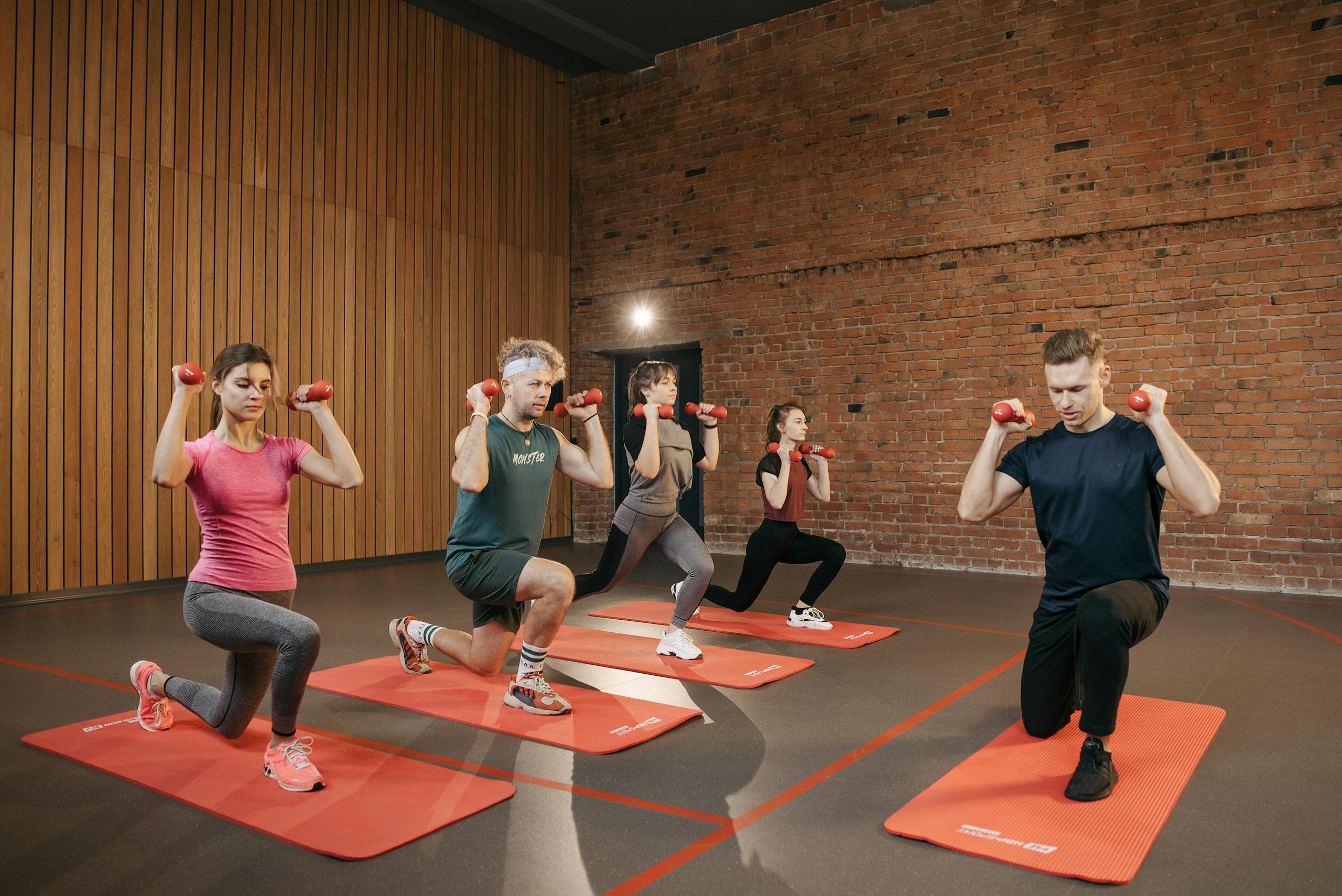Struggling to find time for long workouts but still want results? You’re not alone. Between job demands, work responsibilities, family responsibilities, and social commitments, dedicating hours to the gym feels impossible for most people.
Changing your routine is key to making fitness fit into a busy life.
The good news is that effective fitness doesn’t require marathon training sessions. The key is in strategic programming that gets you the most out of your time. This approach is called “training smarter, not longer” and focuses on quality over quantity to help you achieve your fitness goals efficiently and be more productive in and out of the gym.
Many believe that spending more time in the gym equals better results. This misconception leads to burnout, inconsistency, and frustration when life gets in the way of long workout plans. The truth is that well-designed weekly programming can get you better results in half the time.
This guide will show you how to create efficient workout splits, structure your weekly programming to fit your schedule, and adopt time-saving strategies that don’t compromise effectiveness. You’ll learn to optimize your training, set realistic goal,s and build sustainable habits that work with your busy life.
What Does It Mean to Train Smarter, Not Longer?
Training smarter means optimizing every aspect of your workout to get the most out of your time. Instead of spending hours doing random exercises, you focus on strategic movements and programming that targets your specific goals.
This approach prioritizes quality over quantity in every aspect of your training. Instead of doing countless exercises with mediocre form, you choose fewer, more effective movements and execute them with precision. Each exercise serves a purpose in your program, eliminating wasted time and effort.
Well-designed weekly programming can get you better results in less time by hitting multiple fitness components at once. For example, a properly structured circuit can improve cardiovascular fitness while building strength, so you can get two for one.
This is perfect for busy professionals, students, or parents with tight schedules. When your workout time is limited, every minute counts. Smart programming ensures your short workouts deliver maximum impact, making consistency easier to maintain when life gets in the way.
Control over your schedule helps you stay consistent and reduces stress as you can manage your time better and adapt your routine. It’s normal to fall behind or off schedule sometimes, but the key is to recover quickly and be flexible. Adjust your plan to get back on track.
Assess Your Fitness
Before creating your weekly training plan, you must assess your current fitness level. This step helps you tailor your schedule to your unique strengths and weaknesses so your training is safe and effective. Start by evaluating your endurance, strength, and flexibility – these pillars will guide your progress and help you set realistic goals.
A schedule maker can be a helpful tool in this process. Use it to log your initial assessments, such as how far you can run without stopping, how many push-ups you can do, or how flexible you are in basic stretches. This data gives you a clear starting point and helps you track improvements over time. If you’re a beginner, plan for lower intensity workouts and gradually increase the challenge as your fitness improves. Regularly update your schedule and track your progress, and you’ll stay motivated and see tangible results as you build endurance and strength.
Setting Goals: The Foundation of Training Smart
Clear goals are the foundation of any efficient training program. Without specific goals, you’ll waste time on exercises that don’t align with your desired outcomes. Start by defining exactly what you want to achieve: build strength, lose fat, improve endurance, or overall fitness.
Your “why” drives everything else in your program. Perhaps you want more energy to keep up with your kids, or you’re training for a specific event. Maybe you’re focused on improving your health markers or building confidence. Knowing your motivation helps you prioritize your training time and stay committed when life gets busy.
Effective goals follow the SMART criteria: Specific, Measurable, Achievable, Relevant, and Time-bound. Instead of “get stronger,” aim for “increase my deadlift by 20 pounds in 12 weeks”. This specificity allows you to design a program that directly supports your objective and track progress. When planning your program, consider all relevant factors when estimating how long it will take to reach your goals.
Fitness apps and progress trackers can help you monitor your goals efficiently without adding complexity to your routine. Many apps allow you to log workouts quickly, track key metrics, and visualize progress over time. Choose tools that integrate seamlessly with your lifestyle rather than adding extra time demands and use them to calculate realistic timelines for your goals.
Finally, set clear deadlines for your goals to help you stay focused and motivated.
Building an Efficient Weekly Program
Decide Your Weekly Commitment
Realistic scheduling is the backbone of any training program. Assess your weekly calendar honestly and identify time slots you can commit to exercise. Set a realistic limit on the number of sessions you schedule each week to avoid burnout and maintain a healthy work-life balance. Consistency with fewer sessions beats sporadic, longer workouts every time.
For a 3-day split, focus on full-body workouts that hit all major muscle groups each session. This works well for beginners or those with limited time, as you maintain strength and muscle mass across your entire body even if you miss a session.
A four-day split allows for upper/lower body or push/pull splits, more volume for specific muscle groups, and recovery time. It is suitable for intermediate trainees who want to increase training volume without overwhelming their schedule.
The 5-day split typically follows a push/pull/legs format with additional specialization days. This is advanced and works best for experienced trainees with flexible schedules who want to maximize muscle development and strength gains.
Prioritize Compound Movements
Compound exercises work multiple muscle groups at once and are very time-efficient. Squats work your legs, core, and back. Deadlifts engage nearly every muscle in your body. Pull-ups build your back, biceps, and core strength.
These multi-joint movements also translate better to real-life activities and sports performance. The coordination and strength you develop through compound exercises improve your ability to lift heavy objects, walk, climb stairs, and perform daily activities.
Schedule compound movements early in your workouts when you have the most energy. These exercises demand more focus and technique than isolation movements, so do them first and you’ll get better form and more training benefits.
Sample compound exercises are squats, deadlifts, bench presses, overhead presses, rows, pull-ups, and lunges. Build your weekly program around these movements and, if time permits, add isolation exercises to target specific areas that need extra attention.
Don’t Skip Active Recovery Days
Active recovery is a crucial part of sustainable weekly programming. These sessions promote blood flow, reduce muscle soreness, and maintain movement patterns without adding stress to your system. Active recovery can help you feel refreshed and ready for your next workout.
Yoga, walking, light swimming, or gentle mobility work qualify as active recovery. The goal is movement without intensity so your body can recover while you’re active. Active recovery days also give you mental breaks from intense training while maintaining your exercise habit. This consistency makes getting back into regular workouts easier and reduces the likelihood of missing sessions due to lost momentum.
Schedule active recovery between your most intense training days or use it to stay active on busy days when you can’t fit in a complete workout.
Using a Schedule Maker
A schedule maker is your secret weapon for staying organized and maximizing your training. With a good schedule maker, you can create a personalized schedule that fits your lifestyle, training goals, and daily commitments. Whether you’re juggling work meetings, family activities, or social events, a schedule maker helps you plan your workouts, set reminders, and keep your fitness journey on track.
Look for a schedule maker that’s easy to use and allows you to customize your plan. You can map out your daily workouts, schedule important meetings, and even allocate time for rest and recovery – all in one place. This level of organization makes it easier to prioritize your tasks, avoid scheduling conflicts, and ensure you’re consistently progressing. Using a schedule maker to plan your activities makes it much easier to stick to your training, stay motivated, and achieve your fitness goals.
Choosing the Right Workout Splits
Full-Body Split
Full body workouts train all major muscle groups in each session, making them perfect for beginners or those with limited weekly training time. This split ensures balanced development even if you miss a session occasionally.
Full-body training also improves functional fitness, making everyday household tasks—like lifting boxes, climbing stairs, or moving furniture—easier and safer.
This approach works well for fat loss goals, as full-body sessions burn more calories during and after your workout. The metabolic demand of training your entire body creates an elevated calorie burn that continues for hours post-exercise.
Aim for 2-3 full-body sessions per week, with at least one rest day between intense sessions. Focus on one compound exercise per major movement pattern: squat, hinge, push, pull, and carry.
Upper/Lower Split
The upper/lower split divides training between upper and lower body sessions, allowing for higher training volume while maintaining recovery time. This split works well for intermediate trainees who train 4 days per week.
Upper body sessions focus on pushing and pulling movements for your chest, back, shoulders, and arms. Lower body sessions target your legs and glutes through various squat, hinge, and single-leg movement patterns. This split gives you flexibility in scheduling as you can switch orders based on your weekly commitments. You can train your upper body if your legs are sore instead of missing a workout altogether. And planning for flexibility at the end of the week allows you to accommodate missed sessions and stay on track with your routine.
Push/Pull/Legs Split
The push/pull/legs split organizes training by movement patterns and muscle groups. Push days focus on the chest, shoulders, and triceps. Pull days target the back and biceps. Leg days work all lower body muscles.
This split allows for high volume and specialization while providing recovery time for each muscle group. It works well for advanced trainees who can attend 5-6 weekly training sessions.
The movement-based organization makes exercise selection intuitive and ensures balanced development across opposing muscle groups. This balance reduces injury risk and promotes better posture and movement quality. Experienced coaches can help design push/pull/legs splits that further minimize injury risk by tailoring routines to individual needs and sport-specific requirements.
Maximizing Intensity Without Adding Time
Supersets and Circuit Training
Supersets pair two exercises performed back-to-back with minimal rest in between. This increases workout density by reducing total rest time while maintaining training quality. Pair opposing muscle groups, like chest and back, so one area can recover while you train the other.
Circuit training furthers this concept by linking multiple exercises with minimal rest between stations. This provides cardiovascular benefits while maintaining strength training stimulus, killing two birds with one stone. Circuits can also be done with a team, which helps boost motivation, accountability, and coordination as team members encourage each other and share the workload.
AMRAP (As Many Reps As Possible) sets push your muscles to momentary failure within a specified time frame. This maximizes training stimulus in minimal time while providing clear progression markers from session to session.
Time your rest periods to maintain efficiency without compromising performance. Strength-focused workouts typically require 2-3 minutes of rest, while endurance-based sessions may need only 30-60 seconds between exercises.
Sample Superset Workout
Try this upper body superset to experience the time-saving benefits:
Superset 1: Push-ups paired with bent-over rows (3 sets of 8-12 reps each)
Superset 2: Overhead press paired with lat pulldowns (3 sets of 8-12 reps each)### Superset 3: Dips and bicep curls (2 sets of 10-15 reps each)
Rest 60-90 seconds between supersets, but go immediately from the first exercise to the second in each pair. This should take 25-30 minutes and give you complete upper body training. The structure makes the workout feel less like a chore and more like a part of your routine.
Mental Preparation for Success
Success in training isn’t just about physical effort – it’s also about mental preparation. Building a positive mindset and confidence is key to staying motivated and overcoming obstacles. Start by setting clear, achievable goals and visualizing your success. This mental rehearsal can help you stay focused and committed even when life gets busy.
Use your schedule maker to include mental preparation in your daily routine. Schedule time for meditation, deep breathing, or positive self-talk alongside your workouts. These practices can help you manage stress, build resilience, and stay motivated. By scheduling your physical training and mental preparation, you’ll have a balanced plan for your overall fitness and set yourself up for long-term success.
Recovery is Part of the Process
Recovery is when your body adapts to training stress and gets stronger. Even the most efficient training program will fail to produce results without adequate recovery. Prioritize sleep, nutrition, and stress management as part of your fitness program.
Sleep supports muscle recovery, hormone production, and mental focus for your next workout. Aim for 7-9 hours of consistent, quality sleep each night. Keep your bedroom cool, dark, and quiet to create a sleep-friendly environment.
Nutrition provides the building blocks for muscle repair and energy for your workouts. Focus on adequate protein (0.7-1 gram per pound of body weight), complex carbohydrates for energy, and healthy fats for hormone production.
Recover without additional gym time with simple strategies like foam rolling while watching TV, stretching during work breaks, or taking short walks after meals. These activities promote blood flow, reduce muscle tensio,n and can help decrease pain and discomfort without requiring extra time commitments.
Avoiding Common Mistakes
Even the best training plan can be derailed by common mistakes, but with some planning, you can avoid these pitfalls. Overtraining is a common issue that can lead to injury and burnout.
Use your schedule maker to plan your workouts, including rest and recovery days to keep your body healthy and your motivation high.
Nutrition is another area where many people trip up. Poor eating habits can sabotage your progress and overall health.
With a schedule maker, you can plan your meals and snacks, make healthy choices, and stay energized all day. By organizing your training, nutrition, and recovery in your schedule, you’ll set yourself up for fitness success and stay motivated on your journey.
Progress Tracking
Tracking your progress is key to staying motivated and achieving your fitness goals. A schedule maker makes it easy to log your workouts, set new goals, and see how far you’ve come. Log your daily training sessions, the exercises you do, the weights you lift, and the distances you cover. This log helps you identify patterns, celebrate milestones, and adjust your plan.
Beyond workouts, use your schedule maker to track other vital factors like sleep, nutrition, and recovery. By having all your fitness data in one place, you’ll have a clear picture of your progress and be able to make informed decisions.
Regularly review your achievements to stay motivated, overcome plateaus, and ensure you’re always moving forward on your fitness journey.
Consistency is King
Small, consistent efforts yield better long-term results than sporadic big efforts. A consistently moderate workout over months will produce better results than sporadically perfect workouts. Focus on showing up regularly rather than being perfect in every session.
Create habits that stick by linking your workouts to existing routines. Exercise at the same time every day, lay out your workout clothes the night before, or schedule training sessions like appointments in your calendar.
Find accountability through friends, workout partners, online communities, or fitness apps that track consistency. External motivation helps when internal motivation wanes, keeping you on track to your goals.
Start small and build momentum gradually. If you’re inactive, start with 15-minute sessions three times a week. As this becomes routine, you can increase the duration or frequency without overwhelming your schedule or motivation.
Start Your Fitness Transformation Today
Training smarter, not longer, changes how you approach fitness by focusing on efficiency, consistency, and strategic programming. The principles in this guide will help you get better results in less time and build habits that fit your lifestyle. Follow these principles and you’ll feel more confident in your fitness journey.
Assess your current routine honestly. Are you spending time on exercises that don’t support your goals? Is your program realistic for your schedule? Use the strategies in this post to restructure your weekly programming around compound movements, efficient splits, and time-saving techniques.
Take action today by choosing a weekly split that fits your schedule and writing out your first week of training. Include specific exercises, sets, reps, and rest periods to remove guesswork from your workouts. It doesn’t matter where you’re starting from—anyone can train smarter. The best program is the one you’ll follow.
Ready to take your training to the next level? Download a workout tracking app to track your progress and save time and effort, or work with a qualified trainer who can design a personalized program based on these smart training principles. You can trust their expertise to guide you and help you achieve your goals. Your future self will thank you for committing to train smarter today.
Medical Disclaimer:
This content is for informational purposes only and is not intended as medical advice, diagnosis, or treatment. Always consult with a qualified healthcare professional before making any changes to your diet, exercise, or health routine. Never disregard professional medical advice or delay seeking it because of something you have read on this site.





